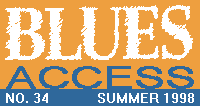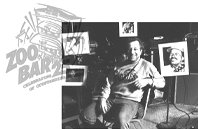
A New Dallas Blues StopYou'll get cussed out at 508 Park Street in Dallas, though it's an address many blues travelers will want to visit, as it seems increasingly likely it was the site of Robert Johnson's historic Vocalion recordings of June 19 and 20, 1937. The building is without a tenant, and the reason you'll get cussed at is because right across the street is the Stewpot, a soup kitchen for people who are derelict and inclined to yell bad words at people who aren't. Chuck Nevitt, founder of the Dallas Blues Society record label, says the address of Johnson's Dallas sessions has been in the literature of blues, but no one seemed inclined to actually seek the place out. Nevitt became intrigued by the thought of tracking it down and verifying specifics when he started pondering whether it might it have been the same place in which the Jay McShann Band cut "Hootie Blues" in 1941. Nevitt's research indicates the Dallas McShann date came during a road tour because of inhospitable union rules elsewhere. McShann cut "Hootie Blues" and three other tracks with producer Dave Kapp April 30, 1941. If McShann did indeed cut at 508 Park Street, this means the apparent site of Robert Johnson's session was also the site of the recorded debut of the saxophone on "Hootie Blues" -- by no less a light than the 20-year-old Charlie Parker! Nevitt learned from Dallas city directories that in 1937 the third floor at 508 Park Street was indeed the site of the Vocalion Records Distribution Warehouse and that Dallas resident Don Law was listed as the office manager there. Law produced the Johnson dates, and the presence of Vocalion and Law at the same address provides strong evidence that it was where Johnson cut his songs -- and there's more that's come to light. A 1941 city directory reveals that the building had changed from Vocalion's warehouse to a warehouse for Decca -- the imprint for which McShann recorded "Hootie." Nevitt sent McShann a photo of the building, and though the pianist could not state for certain that the unimpressive edifice was the one he'd recorded in 57 years ago, he said it "rang a bell." He also remembers the session site was downtown (508 is downtown) and he had to climb "a bunch of stairs" to get to the room where the cutting was done, which in Nevitt's opinion seems consistent with the third-floor location of the recording activities therein. Nevitt next consulted with Smoky Montgomery of the Light Crust Doughboys, who cut in Dallas on the same day as Johnson, and on several later occasions. Like McShann, Montgomery was unable to say with certainty that the building in Nevitt's photo was the one in which he had recorded, but he says he believes it was and recalled the session taking place in a roomful of boxes of 78s, which is what you'd likely have found in a place a business directory called a record warehouse. (Montgomery also recalls it being so hot they cut the session in their underwear!) Researcher Tom Jacobsen, disc jockey Don O and Nevitt contacted 508's present owners (Dallas' Glazer family), and under the pretense of wanting to buy the place, entered and inspected it. Any hope that they might find proof -- establishing session logs or cases of Johnson 78s laying about -- was quashed by the realization that the property has been remodeled extensively, likely more than once since it was built in 1930. (Though presently unused, it was tenanted by offices until 1982.) Back on the street, the blues researchers were taunted by the Stewpot's clientele. Some buffs say more proof is needed before it is stated for certain that 508 is the site it appears to be, though Nevitt is personally convinced. City officials have said the building is considered a historical site because of its age. No city on earth is less respectful of its past than Big D. Here is not the place to discuss how blithely it razes whole neighborhoods to make room for this or that trendy project. But anyone who regards as important a site where Johnson made blues history and Bird debuted, might do well to visit it quickly, before hallowed ground is pitted against those who swing the wrecker's ball. That's a contest in which, this correspondent will assure you, the former has little chance in Dallas. -- Tim Schuller

It's All Happening at the ZooIn 1973 Larry Boehmer, a graduate art student, offered to help some friends attract patrons to their newly purchased bar near the University of Nebraska in Lincoln. All he wanted was the keys to the jukebox. Boehmer filled the music machine with blues and invited friends to hang out with him. Soon he was putting up fliers advertising "Free Juke Box" and "30-cents-a-glass champagne" at the Zoo Bar. Eventually he gave up his painting career and took over the ownership, booking legends of the blues into the narrow, funky little tavern. One of the first acts to play the Zoo was guitarist Luther Allison, who performed with James Solberg after signing a last-minute contract with Boehmer drawn up on a brown paper sack. "Man, we're gon'ta play some blues in here," pronounced Allison as he first set foot in the club. His declaration and scorching performance were an impassioned christening. Boehmer made a fortuitous alliance with Bob Riedy, a Chicago musician taking traditional blues from the ghetto clubs to Chicago's North Side. Subsequently, the Zoo Bar became host to Magic Slim & the Teardrops' first club appearance outside their rough'n'tumble regular Chicago haunts. The Nebraska club became a regular Midwestern stopover for acts like Buddy Guy and Junior Wells, Koko Taylor and Charlie Musselwhite. In the '80s, the club hosted up'n'coming acts like Robert Cray. Old photos and posters lining the club's walls from floor to ceiling document the players who have rocked this house. The Zoo is still going strong. Boehmer's 21-year-old son, Jeff, just started bartending, marking the second generation of Boehmers in the blues business. Six nights a week you'll find the best in local, regional and national blues-based entertainers on the Zoo Bar stage. For blues fans, a trip to the Zoo is like a trip to a national landmark or a religious shrine. Sit quietly in the club in the afternoon or at the end of a long night of music and you can feel the vibrations left by the legendary artists whose sweat and soul has energized the room night after night. The essence of the club boils down to these sorts of intangibles. Says Boehmer, "It's the love, I think between the musicians and the crowd, and it really happens here, you know -- partly 'cause the room is small, and partly 'cause the place feels right for this kind of music. Just the energy is magical at times -- that's what keeps me wanting to do this and working long hours to make it keep happening." Boehmer marks the Zoo's 25th anniversary with a week-long celebration. Beginning July 6, the bar will host three to four national acts each night to celebrate. Passes are already sold-out for the Monday-Thursday performances featuring club favorites like Magic Slim, James Harman, Lil' Ed and the Blues Imperials, Maria Muldaur, Kenny Neal and Solberg. The bash ends July 10 and 11 with an outdoor festival staged in front of the Lincoln club, with the Tommy Castro Band, Coco Montoya, Billy Bacon and the Forbidden Pigs, the Bel-Airs, the Chris Duarte Group and Dave Alvin and the Guilty Men already booked for the two-day street fest. For more information, point your browser to http://members.aol.com./frgtrs/zoo.htm or call the club at (402) 475-3094. -- B.J. Huchtemann
Back on the PorchWhen she was a teenager in the '70s, Belinda Sellari and her friends would occasionally walk over to hear Sleepy John Estes perform in Brownsville, Tennessee, a small town about 50 miles northeast of Memphis, near Interstate 40, the highway that intersects Memphis with Nashville. She recalls Estes' at-home concerts, sometimes with partner Hammie Nixon, who also lived in Brownsville at the time. "We would give him what we could, and they would play," says Sellari. "I remember thinking, 'We should have a billboard for this man,' like 'The Home of Sleepy John Estes.' But it wasn't going to happen at that time. Brownsville wasn't aware of what it had. I knew he was very good and internationally famous but I wasn't aware of his musical history and have always wanted to do something to honor him." Sellari was in college when Estes died in 1977, then moved away for 20 years. She returned to Brownsville four years ago and last December took a part-time job as the city's tourism director. It was then she found that the city had purchased the home where Estes resided at the time he died and was planning to fix it up and relocate it as part of a museum and information center near I-40. The museum complex is slated for late 1998, but with the house sitting unused in a lumberyard awaiting repairs, Sellari had a better idea: Why not put the home near the city park next to the public library until the museum was completed? To that end she planned an official grand-opening celebration for the weekend of June 13 and 14. Appearing on an extended porch of the newly weatherproofed two-room shotgun shack that Sunday are Estes' friends Jim Dickinson, Alex Harvey, Paul Rishell and Annie Raines and Dr. David Evans, among many others. When Sellari tried to contact members of Estes' family in town -- including his widow and several of his children -- to invite them to the ceremony, she found the family members living in extreme poverty. After meeting with them, she made a few calls, including one to Dick Waterman, who's looking into getting royalty payments due the singer to the family. Waterman brought the matter to the attention of Bonnie Raitt, a known activist regarding the plight of blues artists. Sellari is still concerned about basic things like funding for the future maintenance of the house, but she would like to see the family get something too. At this point, though there is no admission planned for the concert nor an entrance fee for touring the house, she will accept donations for the family at the house, and perhaps do a benefit for them. "We want to work in any way to help them, even if it's just proceeds from a yearly concert. The world respects John Estes' music," Sellari says. "I'm hoping that with this Brownsville will respect his music as well." Donations for the family can be addressed to Sellari c/o the Brownsville/Haywood Chamber of Commerce, 121 W. Main St., Brownsville TN 38012, or call Sellari for more information at (901) 772-2193.
Send information for this column to ACCESS, c/o BLUES ACCESS, 340 S. 42nd, Boulder, CO 80303, fax to (303) 494-1127 or e-mail Lrucker@aol.com.
|


